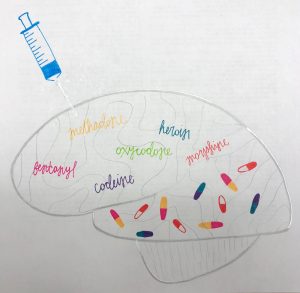The opioid epidemic has become an enormous issue nationally. In the United States, a public health emergency was declared in 2017 in relation to the opioid crisis. Based on data from 2016 and 2017, more than 130 people die each day from opioids, 11.4 million people have abused prescription opioids, and 42,249 people have died from opioid overdose. This issue is harming individuals all over the country and has everlasting effects. In order to combat this issue, there must be more knowledge, less stigma, and a greater understanding of addiction as a whole in order to fight this crisis.

There are many misconceptions about addiction, specifically opioid addiction, including “Why don’t they just quit?” or “Why do something that causes you so much harm when you could just choose not to?”. Even though it may seem easy to choose a life without opioids to an outsider, it becomes less and less of a choice when looking at the brain of an addicted individual. Addiction vulnerability of each individual is 50% accounted for by genetic factors, made up of hundred of genetic variations. The remaining 50% is accounted for by various combinations of environmental factors, causing an individual to be more vulnerable to addiction. Some risk factors that contribute to opioid addiction are:
- “gateway” drugs such as prescription medication, marijuana, alcohol, and nicotine
- anxiety or depression
- other psychiatric disorders
- exposure to abuse or trauma
- family or friends addicted to drugs
- access to addictive drugs
- starting substance abuse at a young age
- poverty
There are many reasons why an individual may be more predisposed to becoming an addict. In addition, there are specific changes in the brain that occur in order to cause specific symptoms of addiction to occur if an addicted individual tries to “quit”, such as craving, withdrawal, and relapse.

These changes in the brain include changes to certain nerve cells due to drug exposure, causing the neurons to respond differently to drugs, changes that occur in response to addiction, such as altered gene transcription, synaptic plasticity, and neurotrophic mechanisms, and changes in key neural substrates or brain regions of behavioral memory. These alterations cause caring and relapse as there are differences in the memory circuits due to addictive drugs.

Since it is clear that addiction is not necessarily a “choice”, the U.S. population as a whole must become more aware of the opioid crisis in order to begin finding solutions. In order to target the opioid epidemic, there must be a greater awareness of how addiction occurs, what is happening in the brains of addicted individuals, and how to target therapies and treatments to each specific individual. Stated in the facts above, the opioid epidemic is affecting millions all over the nation and must be addressed. By understanding the factors that play in to addiction and gaining knowledge about each addict’s personal situation, treatments and solutions may become more accessible.
https://www.centeronaddiction.org/addiction/addiction-risk-factors
https://www.hhs.gov/opioids/about-the-epidemic/index.html